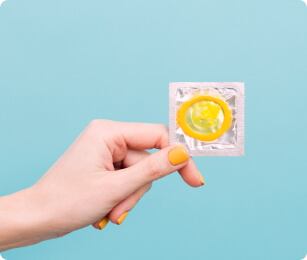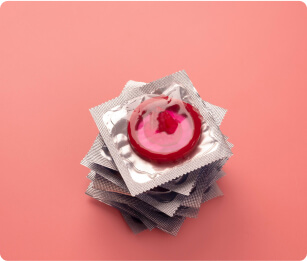Sexual health is a crucial aspect of our overall well-being. Infections in the genital area are relatively common and can affect both men and women. Genital infections can be caused by various bacteria, viruses, parasites, or fungi. Some of them are referred to as STIs because they are transmitted through sexual contact. In the Netherlands, the incidence of various STIs increased again in the past year.


Additionally, genital fungal infections are also quite common. For instance, 75% of all women experience a genital fungal infection at some point in their lives. Distinguishing whether symptoms are caused by an STI or a genital fungal infection is not always straightforward; they often present almost identically. That’s why in this article, we delve deeper into these two common issues: STIs and genital fungal infections. What are the differences between them? How can you distinguish between the two? And how can you determine which condition is causing your symptoms? Read this blog, and you will discover the answers to these questions.

Which STI resembles a genital yeast infection?
Genital yeast infections and STIs share multiple similarities but are two entirely different conditions. Particularly, the STIs chlamydia, gonorrhea, trichomoniasis, and genital herpes can exhibit similarities to a genital yeast infection, making them occasionally challenging to distinguish. The similarities between an STI and a genital yeast infection include:
Symptoms: Genital yeast infections and STIs can cause similar symptoms, such as a burning or painful sensation during urination, redness, blisters, and discharge from the vagina or penis. These symptoms can be triggered by yeast but also by various STIs like chlamydia, gonorrhea, and trichomoniasis. Blisters may occur in a genital yeast infection but can also be present in genital herpes or syphilis.
Localization: Both STIs and yeast infections can induce symptoms in the genital area. Additionally, both conditions can cause (different) symptoms in other parts of the body.
Transmission: While STIs are always transmitted through sexual contact, there is a small chance that a genital yeast infection may also be transmitted through sexual contact. The symptoms of a yeast infection are primarily caused by an overgrowth of naturally occurring yeast on the body. Sometimes, it can result from an individual being exposed to a significant amount of yeast from their partner, causing an imbalance in yeast for the individual. However, this is not the predominant way a (genital) yeast infection develops, and this is also the reason why a genital yeast infection is not classified as an STI.




Difference between STI and yeast infection
As mentioned earlier, an STI and a yeast infection are two entirely different conditions. Despite their several similarities, as mentioned above, it’s also crucial to understand the differences between these two conditions.
The primary distinction between STIs and genital yeast infections lies in their causes and treatment. Let’s break it down:
Causes: STIs are caused by bacteria or viruses, whereas yeast infections result from yeast. Moreover, these yeasts are often naturally present in the genital area but cause symptoms due to overgrowth and imbalance in the composition of this microflora. The virus or bacteria causing an STI does not naturally occur in the genital area and is acquired only through sexual contact with an infected person.
Symptoms: Although STIs and genital yeast infections share similar symptoms, each condition has specific symptoms that do not occur in the other. For instance, a genital yeast infection does not cause fever or swelling of the lymph nodes, whereas these may occur with some (serious) STIs. Genital yeast infections also do not result in lower abdominal pain, a symptom seen in some (serious) STIs.
Treatment: STIs are treated with antibiotics or antiviral medications, while yeast infections are treated with antifungal agents.
Complications: Untreated STIs can, in some cases, lead to severe health problems, while yeast infections are usually less severe.


What does a yeast infection look like?
A genital yeast infection is a common condition that can affect both men and women. 75% of all women experience a vaginal yeast infection at some point in their lives.

A vaginal yeast infection occurs when the natural balance of microorganisms in the vagina is disrupted. Normally, the vagina harbors a diversity of fungi and bacteria that form the healthy vaginal microbiome. Candida albicans, a type of yeast (i.e., a single-celled fungus), naturally resides in the vagina. When the balance in the vagina is disturbed, certain microorganisms can begin to overgrow, and Candida albicans is one of the most common fungi that can cause such overgrowth.
Although genital yeast infections in men occur less frequently than in women, they are by no means rare. It is typically caused by Candida albicans, the same yeast that causes vaginal yeast infections in women. This infection in men is known as balanitis (inflammation of the glans) or balanoposthitis (inflammation of the glans and foreskin), depending on which part of the male genitalia is affected.



When a fungus, such as Candida albicans, overgrows, it can cause various symptoms. We will guide you through the different symptoms of genital yeast infections, STIs, and the variations between men and women.
Symptoms of Genital Yeast Infection
Both men and women can experience symptoms due to an overgrowth of genital yeast infection.


Genital Yeast Infection in Women:
- Itching in and around the vagina. A common characteristic of a genital yeast infection is itching specifically localized in and around the vagina. It can cause an irritating, burning, or painful sensation.
- Burning sensation during urination or intercourse. Genital yeast infections may be accompanied by a burning sensation during urination or sexual intercourse. This often comes with a feeling of irritation and sensitivity in the genital area.
- White, grainy discharge. Another characteristic symptom of a genital yeast infection is the presence of white, grainy discharge. This discharge may resemble cottage cheese and sometimes have an unpleasant odor.
- Redness and swelling of the vulva. Genital yeast infections can lead to redness and swelling of the vulva, the outer part of the female genitalia. This may be accompanied by a burning or painful sensation.
Genital Yeast Infection in Men:
- Itching and redness around the glans. A common sign of a genital yeast infection in men is itching and redness, usually around the glans.
- White discharge under the foreskin. Some men with a genital yeast infection may have white discharge under the foreskin. This substance may have an unpleasant odor.
- Burning sensation during urination or intercourse. Genital yeast infections can be associated with a burning sensation during urination or sexual activity.
- Redness and swelling of the foreskin. A genital yeast infection can lead to redness and swelling of the foreskin.
It is important to note that not everyone with a genital yeast infection experiences symptoms. If you are a woman and want to learn more about genital yeast infections, read our comprehensive blog on vaginal yeast infections, or opt for certainty and take the Easly Female Intimate Health test.
What Does an STI Look Like?
STIs constitute a diverse group of sexually transmitted diseases that can be transmitted in various ways, causing different symptoms and complications. The five most common STIs are referred to as “the big five”: chlamydia, gonorrhea, syphilis, hepatitis B, and HIV. Not all STIs always cause symptoms. Some may cause no symptoms at all, while others may only manifest symptoms at a later stage, despite the individual being contagious.
Not all STIs present the same symptoms. In general, consider an STI when experiencing the following symptoms:
STI Symptoms in Women:
- Unusual vaginal discharge.
- Pain or burning sensation during urination.
- Lower abdominal pain.
- Pain during sexual intercourse.
- Vaginal bleeding between menstruations.
- Swellings, bumps, blisters, or sores on the vulva.
STI Symptoms in Men:
- Unusual discharge from the penis.
- Pain or burning sensation during urination.
- Pain or burning sensation during sexual intercourse.
- Swelling or sensitivity of the testicles.
- Itching and redness around the glans.
- Swellings, bumps, blisters, or sores on the foreskin or glans.




These are general symptoms that can occur with various types of STIs. For detailed information on which STI causes specific symptoms, read our comprehensive blog on all STIs and their specific symptoms.
Symptoms caused by a genital yeast infection bear many similarities to STI symptoms. If you are still uncertain and wondering, “Do I have an STI or a yeast infection?” We can help! At Easly, we offer multiple tests to determine whether you have an STI or yeast infection. Take our Easly STI Basic test or Easly STI Complete test to easily find out if your symptoms are caused by an STI. If you’re a woman experiencing any of the above symptoms, try the Easly Female Intimate Health test to determine if your symptoms are caused by a vaginal yeast infection.
Related tests

Prevention of STIs and Yeast Infections
To prevent discomfort and issues, it’s crucial to understand how to reduce the risk of contracting an STI and/or yeast infection. STIs and yeast infections can be prevented through various methods, which we’ll elaborate on below:



Preventing an STI:
- Safe Sexual Behavior: Always use a condom during sexual activities with an unknown partner or if either of you hasn’t been recently tested for an STI. Condoms reduce the risk of most STIs but don’t provide complete certainty.
- Regular STI Screening: Get tested regularly for STIs if you’re sexually active, especially with multiple partners. Early detection is essential for prompt treatment and preventing further spread. With Easly, you can easily perform an at-home STI test.
- Avoiding Multiple or Changing Sexual Partners: The more sexual partners you have, the higher the risk of contracting an STI. Test regularly and be open about your test results with your sexual partners.
- Vaccinations: Consider vaccinations against specific viral STIs, such as hepatitis B and human papillomavirus (HPV). Consult a doctor for vaccination advice

Preventing a Yeast Infection:
- Avoid Certain Products: Refrain from using soap, vaginal douches, spermicides, or products like Lactacyd, as they may cause irritation.
- Gentle Cleansing: Wash with lukewarm water; this is sufficient for cleanliness.
- Limited Scientific Evidence: There’s insufficient scientific evidence that substances like vitamin C, garlic supplements, tea tree oil, or probiotics prevent a yeast infection.
- No Evidence of Causation: There’s no scientific evidence that tampons, panty liners, or tight-fitting clothing cause a yeast infection.
Conclusion
In this blog, we’ve guided you through the similarities and differences between STIs and genital yeast infections. While the symptoms of a yeast infection and an STI may overlap, clear distinctions exist. They are treated differently, have different causes, and can be prevented in various ways. If you are sexually active, we always recommend getting tested regularly for an STI to prevent potential complications and further transmission.
If you’re experiencing symptoms and want to determine whether they are caused by a genital yeast infection or an STI, Easly offers multiple tests that can provide clarity: take the Easly STI Test Guide or the Easly Female Intimate Health Test. For personalized medical advice regarding your symptoms, it’s advisable to consult your own (general) practitioner first.










